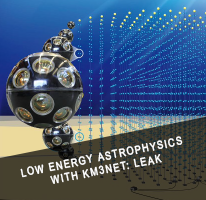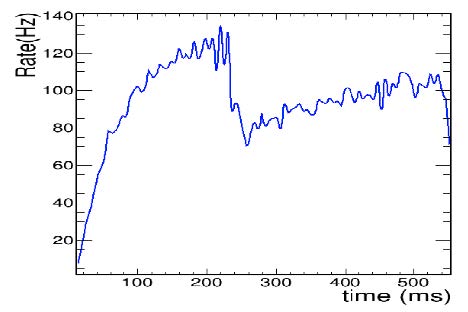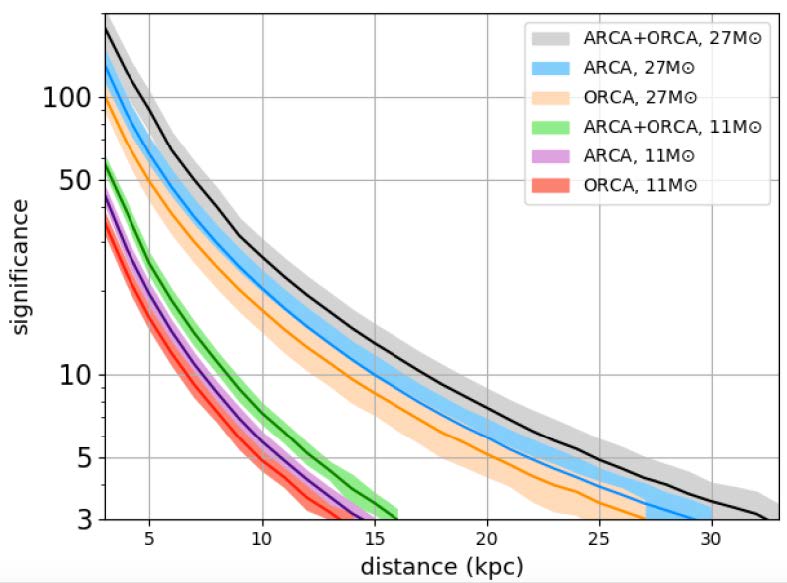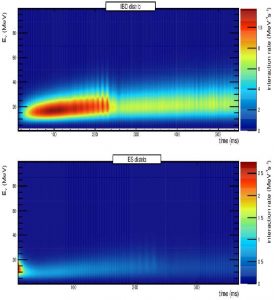E9 : Low energy astrophysics with KM3NET
> Read the articles connected to the project.
.
-

Although multi-wavelength observations of core-collapse supernovae (CCSN) are now routinely performed, specific features of the gravitational collapse can only be diagnosed by neutrinos.
The objective of this exploratory project is to bring together experts in CCSN physics and members of the KM3NeT collaboration to assess the capability of the KM3NeT neutrino telescopes (optimized for GeV-PeV neutrinos) to detect MeV neutrino signal from the next close-by CCSN.
Using state-of-the-art numerical simulations and theoretical developments, we explore the potential of the novel KM3NeT optical module design to efficiently suppress the background, and thus to detect features of the neutrino light curve related to hydrodynamical instabilities, neutron star equation of state, and neutrino properties.
.
-
POSITION NAME SURNAME LABORATORY NAME GRADE, EMPLOYER WP leader Alexis Coleiro APC Post-doc, IFIC / APC, associate researcher WP co-leader Thierry Foglizzo AIM IR, CEA WP member Julien Aublin APC MCF, UPMC, associate researcher WP member Bruny Baret APC CR, CNRS WP member Julien Aublin APC MCF, UPMC, associate researcher WP member Marta Colomer-Molla APC PhD student, Univ. Paris Diderot / IFIC
ValenciaWP member Antoine Kouchner APC PR, Univ. Paris Diderot WP member Micaela Oertel LUTh CR, CNRS WP member Bruno Pagani AIM PhD, ED127 WP member Cristina Volpe APC DR, CNRS -
Massive stars are tightly linked to crucial open questions in astrophysics. In particular, understanding their explosive death as a core-collapse supernova (CCSN) is crucial to assess not only the question of the formation of compact objects (neutron stars and/or black holes) but also the chemical enrichment of the Galaxy. During a CCSN, ~99% of the gravitational binding energy is released in the form of neutrinos with energies of a few tens of MeV over a timescale of a few seconds. However, their detection remains challenging and only close-by SNs can be observed.
The main purpose of this exploratory project is to test the CCSN detection capabilities of the new-generation neutrino telescope KM3NeT. Although KM3NeT detectors are optimised for the detection of atmospheric neutrinos in the GeV range (KM3NeT-ORCA) and cosmic neutrinos in the TeV-PeV domain (KM3NeT-ARCA), we are trying to make the most of the KM3NeT design, using full Monte-Carlo studies, in order to infer its potential sensitivity to a CCSN signal. Observing a high-statistics CCSN neutrino signal represents an extremely rare opportunity of obtaining numerous constraints on the core-collapse mechanism and neutrino properties. This provides a strong motivation for such a study, in anticipation of a forthcoming Galactic CCSN.
The main interaction modes of these MeV neutrinos in water are the interactions with (i) free protons (Inverse Beta Decay, IBD), (ii) electrons (Elastic Scattering, ES) and (iii) Oxygen nuclei. The outgoing particles (electron or positron), produced through these interactions, radiate Cherenkov light that can be detected by photomultiplier (PMT) arrays. Although KM3NeT detectors are suffering from a large optical background, due to both 40K decay in sea water and bioluminescence, it can be significantly reduced by using nanosecond coincidences between nearby PMTs (hereafter called multiplicity). The Exploratory project “LEAK” aims at investigating these capabilities.
In particular, the fundings obtained in 2017 have facilitated the organization of face-to-face meetings to start the implementation of a complete simulation of KM3NeT sensitivity to MeV neutrinos as described hereafter. The development of this simulation was identified as a critical milestone of the project and has been started by Marta Colomer-Molla during her M2/NPAC internship. She is now continuing the project as a PhD student in the KM3NeT collaboration (cotutelle between the University Paris Diderot/APC and the University of Valencia/IFIC), exploiting the results of this simulation to test KM3NeT sensitivity to CCSN neutrinos. Promising results obtained in the framework of this LabEx project were presented at a dedicated workshop organized thanks to the LabEx funds in
July 2018. As described hereafter, this meeting triggered a new fruitful collaboration on the multimessenger perspective with researchers from both the IceCube and SNEWS collaborations, in which the team involved in the LabEx project will play a key role in the near future.1) Monte-Carlo simulation of KM3NeT in the MeV domain
The simulation of the neutrino interactions was started in 2017 with the aim of exploring the capabilities of KM3NeT to detect CCSN neutrino events. This work was performed by the KM3NeT team involved in the LabEx project, together with KM3NeT groups in CPPM/Marseille and IFIC/Valencia.

Figure 1 Rate of !?!?! in the simulation of the CCSN accretion
phase including the SASI oscillations at about 200 ms.
Simulation from the Garching group used as an input of
our Monte-Carlo simulation.In close collaboration with Thierry Foglizzo (AIM/CEA Saclay) and Thomas Janka (MPE/Garching), the latest 3D CCSN simulations [1] from the Garching group have been obtained. With detailed neutrino transport incorporated, the modulation of the SN neutrino signal due to the hydrodynamic instabilities (in particular the SASI instability) are clearly observed in these models (see Fig. 1) and consequently, these simulations allow for
a detailed study of KM3NeT sensitivity to these specific features.Inverse Beta Decay (IBD), elastic scattering interaction channels and neutrino interaction with oxygen atoms have been simulated using cross section parameterizations. The resulting SN interaction rates are shown in Fig. 2 for a generated volume of 4.2 ktons of water. The full positron (electron) spectrum is used to get the information relevant for each interaction.
The propagation of the outgoing relativistic particles and the propagation and detection of the resulting Cherenkov light are simulated using a GEANT4 simulation developed in the KM3NeT collaboration to this purpose. It takes into account the PMT efficiencies and absorption length.
We now have a complete analysis framework, composed of a full Monte-Carlo simulation of the KM3NeT detectors in the MeV energy range, and state-of-the-art numerical simulations from the Garching group to accurately estimate the sensitivity of KM3NeT to a galactic CCSN
2) Results
The output of this Monte-Carlo simulation allows for a detailed study of the sensitivity of KM3NeT detectors to a CCSN neutrino signal, which was carried out in 2018.
Namely, the capability of KM3NeT to detect a Galactic CCSN was estimated together with the possibility of detecting features of the neutrino lightcurve related to the SASI instability, reconstructing the neutrino energy and the source direction. Finally, the sensitivity to the neutrino mass hierarchy was assessed based on the latest available models.CCSN detection significance:
As a first step, we addressed the capability of detecting a CCSN with KM3NeT based on the neutrino emission models from the Garching group (see above). Thanks to (i) an optimization of the multiplicity cuts to filter 40K and bioluminescence optical background, (ii) the development of an efficient muon filtering and (iii) a proper estimate of the systematic uncertainties, we were able to demonstrate KM3NeT capability to detect a Galactic supernova. The results for both ORCA and ARCA are shown in Fig. 3 for two different stellar progenitors. Using data from both detectors, KM3NeT will be able to detect a CCSN with a significance of 5σ up to 25 kpc ensuring the coverage of the full Galaxy assuming a 27 M? stellar progenitor. In the case of a lower mass progenitor (11 M?), a significance of 5σ is reached up to the Galactic center using ORCA alone.
 Figure 3 Significance versus distance assuming the CCSN models of Garching for KM3NeT ARCA, ORCA and the combination of both detectors.
Figure 3 Significance versus distance assuming the CCSN models of Garching for KM3NeT ARCA, ORCA and the combination of both detectors.CCSN neutrino lightcurve:
The latest 3D simulations predict anisotropic hydrodynamic instabilities happening during the accretion phase of the CCSN explosion, that might play an important role in the neutrino heating. In particular, the Standing Accretion Shock Instability (SASI) could explain the energetic explosion and should leave as footprint fast time variations in theneutrino lightcurve around 200 ms after the core bounce, with a characteristic oscillation frequency (see Fig. 1).
Another key work of the project was to estimate the capability of KM3NeT to detect this signature. Including the background rates as measured in the first KM3NeT data, we were able to show that the SASI oscillations will be detected at 5σ for a CCSN exploding at 5 kpc. If detected, those features would lead to a detailed understanding of the explosion mechanism.Reconstruction of the neutrino energy (preliminary study):
Although reconstructing the neutrino spectrum of the next Galactic CCSN is of primary importance to test theoretical models, it remains challenging with water Cherenkov detectors such as KM3NeT. However, one can take advantage of the fact that higher-energy neutrinos (on average) will produce more events at high multiplicity (detected over
multiple PMTs). Simulations for different sets of average neutrino energy and spectral shape have been performed.Preliminary results are promising since they show that for a CCSN at 10 kpc, an energy resolution of 10% can be achieved with KM3NeT.
Sensitivity to the neutrino mass hierarchy (preliminary study):
Following an approach developed by Serpico et al. (Phys. Rev. D 85, 085031), the rise time of a Galactic CCSN ?! lightcurve can provide a diagnostic tool for the neutrino mass hierarchy at large 1-3 mixing angle ?!”. Assuming this assumption is true, we demonstrated that KM3NeT can distinguish both hierarchies with a significance of 3σ for a
CCSN occurring at the Galactic center, thus providing a complementary measurement of the neutrino mass hierarchy which should be confirmed by KM3NeT/ORCA observations of atmospheric neutrinos.3) Implementation of the triggering tools in KM3NeT data acquisition system
An approach for the real-time triggering of a CCSN neutrino burst, applicable to both ORCA and ARCA is under study. Data from the first deployed ARCA and ORCA lines are currently analyzed by sampling the background on a 100 ms timescale in order to identify patterns in the DOM response that could mimic the SN signal. As the supernova neutrino burst is expected to produce a sparse signal (around one coincidence per line over a few hundreds ms), we are currently trying to implement a robust trigger by defining the trigger level as the number of DOMs that detect a coincidence in a defined multiplicity cut over a sliding time window. This work is ongoing and will constitute one of the tasks to be achiveved in 2019 together with the implementation of the trigger in the data acquisition system
of KM3NeT to allow for a CCSN signal search as soon as KM3NeT ORCA and ARCA start taking data (expected early 2019).4) Organization of an international workshop on CCSN neutrino detection
All those results were presented by Marta Colomer during an international workshop on CCSN neutrino detection that was organized in Orsay on July 4 and 5, 2018 thanks to the LabEx funds. 45 persons attended the workshop among whom 7 foreign experts on CCSN neutrino physics (from the USA, Japan, Spain, Italy, and Germany) were invited. The LabEx funding allowed to support the travel and hotel costs of the invited speakers as well as the booking of the meeting room at the Institut de Physique Nucléaire d’Orsay (IPNO). The program and the presentations given during the workshop are available on the meeting website at https://indico.in2p3.fr/event/17490/timetable/
This workshop allowed for fruitful discussions and new collaborations. In particular, the question of the reconstruction of the supernova direction through triangulation method was raised in the context of the SNEWS project which involves an international collaboration of experimenters representing current supernova-neutrinosensitive detectors to provide the astronomical community with a prompt alert in case of a Galactic CCSN event. The capability of exploiting this method to reconstruct the supernova direction in the sky depends on the accuracy of the measurement of the explosion time through neutrino detection, which is also of primary importance for a multimessenger detection of CCSNs (see section III-3). In this context, this task has been identified as one of the next
important milestones of our LabEx project which is expected to be fulfilled in 2019. -
Marta Colomer Molla & Massimiliano Lincetto, 2018
CCSN neutrino detection with the KM3NeT neutrino telescopes
Proceedings of RICAP 2018, in press.Marta Colomer Molla & Massimiliano Lincetto, 2018
Study of KM3NeT sensitivity to CCSN MeV neutrinos
Proceedings of VLVnT 2018, in press.Marta Colomer Molla & Massimiliano Lincetto,
Study of KM3NeT telescopes potential to CCSN neutrino signal
internal note of the KM3NeT collaboration.M. Colomer-Molla et al. on behalf of the KM3NeT collaboration, ICRC 2017 proceedings.

